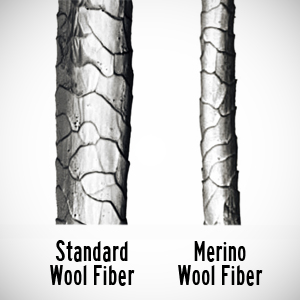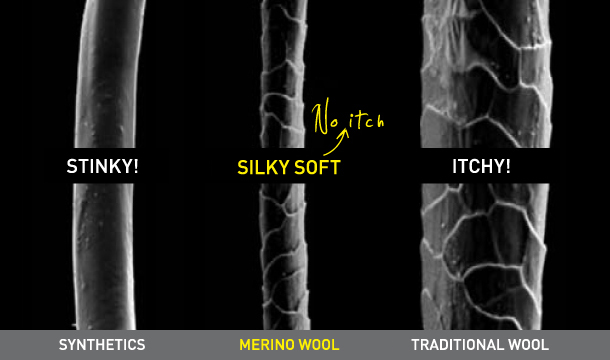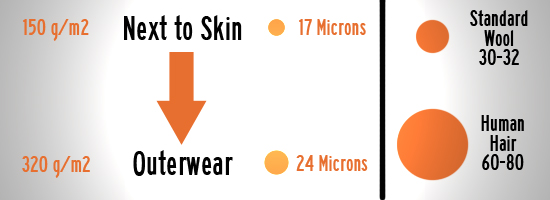Merino Wool
When you think wool, you think hot and scratchy. It isn't true! Merino has a soft and smooth texture, which is very different from the itchy feeling of your traditional wool. Additionally, the keratin found in merino has been proven by dermatologists to be beneficial to the softness of human skin. Merino fiber is the most hydrophilic of all fibers and can absorb and leak up to 10 times more moisture than synthetic fiber. Each fiber can absorb more than one third of its own weight without feeling wet or getting wet touch. Merino clothing can leak moisture into the atmosphere to keep the body warm and dry.
NOT SCRATCHY
Wool fibers are generally measured in microns (A micron equals one millionth of a meter). The smaller the micron gauge the finer and softer the wool fiber. Merino wool fiber is between 15 - 25 microns. It is much more thinner than traditional wool fibre that has between 30-32 microns. Most people feel scratching from fibers stronger than 28 microns. Thinner fibers not scratch excessively, because they bend at skin contact.
WATER RESISTANT
Wool surface is hydrophobic - water resistant. It is coated with lanolin, a waxy, water shedding film.
YOU DON'T FEEL WET
The core of the wool is hydrophilic - water loving. It can absorb up to 35% of its volume and weight without you feeling wet.
REGULATES TEMPERATURE
Wool has the ability to regulate body temperature. Merino wool naturally regulates your temperature by absorbing and releasing moisture, keeping you warm when its cold and cool when it's hot. Wool absorbs sweat vapor and releases it on the other side; preventing clamminess and the wet feeling against the skin. Synthetic clothes feel cold because they transport moisture between hydrophilic fibers to the outside of the garment to evaporate. This requires sweat to condense before it is moved through the fabric.
GREAT FOR WARM WEATHER
That wool is great for cold weather we all know. But not many know wool is perfect for a hot summer's day. In the Sahara, the Bedouins wear also a thin wool layer to keep them cool. As sweat evaporates from your skin it cools the skin and the nearby air. The millions of air pockets created by the crimps in the wool trap this cool air and protect you from the warmer temperatures outside. The core (cortex) of the wool fibers are hydrophilic (moisture loving) and can absorb 1/3 of their weight in water (estimates are from 27%-36%) without feeling damp. The exterior of wool fibers are hydrophobic (moisture hating). This means that while the fibers can absorb sweat, against the skin is the hydrophobic layer so your skin will feel dry even if the fabric is soaked with sweat. In this condition the fabric may feel slightly heavier than in its dry state.
ULTRA BREATHABLE
Each fiber merino wool breathes with its internal structure, and so even thickly woven woolen fabric is very breathable. The permeability of synthetic fibers is determined by a number of gaps in the material, so thick knitted synthetic shirt is not breathable and feels like a plastic bag.
ANTI-ODOUR PROTECTION
Wool contains lanolin which has antibacterial qualities. Since wool also absorbs water into the inside of the fiber, there is no moisture on the outside that microbes can grow on. This is what keeps wool garments from smelling.
UV RESISTANT AND FLAME RETARDANT
Wool has a lower propensity for ignition, and burns with a lower heat than all other textile fibers. The protein Keratin does not support combustion. While the application of flame to the fiber will initially cause some smoldering, it will not ignite. In comparing wool to synthetic fibers, wool will not melt when burned. Wool provides high UV protection.
SIMPLE WOOL CARE
Just wash it once in a month. No need to iron
VERSATILE
Wool is also versatile in it's uses as a cover. You can choose from so many types and designs.
ECO-FRIENDLY
Wool is also natural, biodegradable, and renewable. It also can be produced using less petroleum and fewer toxic chemicals than its synthetic competitors.
GOOD FEELING
Every time you put a wool diaper cover on your child you just feel really good about it. Knowing you are giving the baby the very best by using cloth diapers and wool for a breathable and all natural diapering system.
ALLERGY TO WOOL
Wool is mostly non-allergic. For those with sensitive skin, wool is a great choice. Some babies may have allergic reactions to the lanolin in wool, just make sure it's not a reaction to chemicals used to treat it.
FOR COMPARSION
1. merino wool fiber vs standard wool fiber:

2. merino fiber vs standard wool fiber vs synthetic fibre

3. Modern Merino Wool is between 17.5 – 24 microns. The 17.5 micron wool is used in lightweight next-to-skin garments where 24 micron wool is used in outerwear garments such as sweaters. To give some perspective, a human hair is 60-80 microns. Old school wool sweaters were generally made out of 30-32 micron wool fibers. (This wool was scaly, scratchy, heavy, and had a tendency to shrink.)








